A Most Auspicious Star
But stay, I see thee in the Hemisphere
Advanc’d, and made a Constellation there !
Shine forth, thou Starre of Poets…
~ Ben Jonson, “To the memory of my beloued, The AVTHOR…”
This week, it’s my pleasure to publish a delightful Oxfordian find that landed in my mailbox a few days ago. I do believe that what follows contains a vital new clue to the perennial mystery surrounding “The AVTHOR” of Shake-speare’s Sonnets.
~*~*~*~*~*~*~*~*~*~*~*~*~*~*~*~*~*~
by Richard J. Kennedy
In 1640, the publisher John Benson put forth a curious edition of Poems: Written by Wil. Shake-speare. This was more or less the 2nd edition of the 1609 Sonnets, with a few omissions and some extra text in praise of the poet. Amongst the many small changes in this later quarto, there are questions for the close lookers-on who have a suspicion that the makers of this 1640 edition were puzzling with the reader.
The book opens with several questions. First, there’s the frontispiece portrait. The proportions are all off and the gentleman poet, if taken to be the Stratford man, is wearing the cape of a courtier, much above his station. The verse below says that “This Shadowe is renowned Shakespear’s ?” Yet the man casts no shadow, but like some gothic undead-creep who shows no reflection in a mirror, so it is with the sitter, unless that white space is meant to be a halo.
Well, the writer poses Shakespeare’s name as a question anyway, and follows with two more question marks (the applause? delight?) where none would be wanted. Then the concluding couplet of the frontispiece poem lays out a couple of trim anagrams for Vere, precious in the sight of Oxfordians:
For ever live thy fame, the world to tell,
Thy like, no age, shall ever parallel.
In the 1609 edition of the Sonnets, the dedication page was found out by John M. Rollett to hide a cipher, which reads: “THESE SONNETS ALL BY EVER” – playing on the same ‘ever’ anagram for Vere.
Given these several visual and typographic examples of playfulness on the frontispiece of the 1640 Poems, perhaps there’s more to be found out in the front matter of that edition. On the next page, we find a letter “To The Reader”, signed by “I.B.” (presumably John Benson) , in which the text is all italic except, in the fifth line, where the name of ‘William Shakespeare’ is straight up Roman, and on the second page, first line, the word ‘Seren’ is set in the identical font.
When the text is glossed by the scholars, they often take ‘Seren’ to be a misspelling, and report the word as ‘serene’, which is fine in context, but perhaps the writer is playing with us and he really means ‘Seren’ exactly as it’s printed.
Those two exceptions may only be the sort of haggard type-setting and approximate spelling often found in texts of that time. Yet if not a mere fumbling of some apprentice printer’s devil, why set the name William Shakespeare and Seren in typographic company, perhaps drawing Seren to our special attention in this large field of otherwise italic type?
A pleasing answer might be that Seren is the Welsh word for “Star”…
…and that we are to take the word as an epithet for De Vere because a single star is quartered in his shield, and we might remember that the Chorus in Henry V proclaims the king to be “this star of England”. The phrase is also the happy choice for the title of the Oxford biography by Charlton and Dorthy Ogburn.
The 1640 Poems can be found in facsimile at the Rare Book Room
yn seren mwyaf addawol — Prospero
Richard Kennedy, independent researcher and prolific writer of children’s books, known for his “wit, iconoclasm, wild exuberance, narrative skill and poetic prose” (Children’s Books and their Creators), was the first to identify John Ford as the author of The Funeral Elegy by “W.S.”, (NY Times, 2002) and the first to propose that Shakespeare’s Stratford Monument is actually a bust of William’s father, John Shakspere, the “Woolpack Man” (TLS 2006).

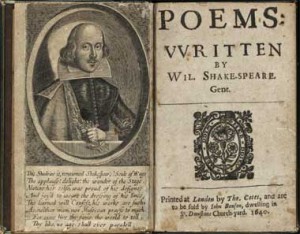
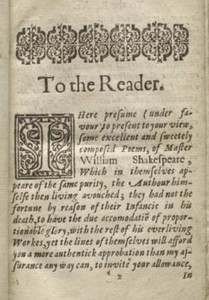
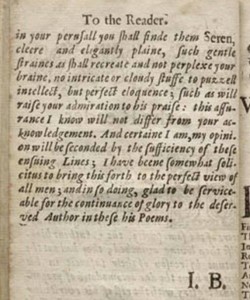
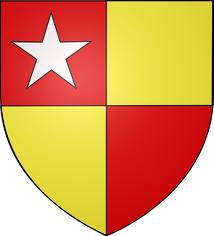
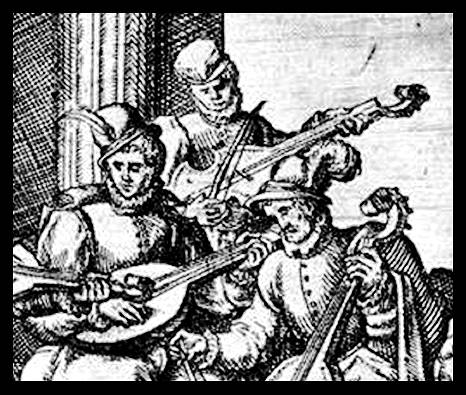
You are right, of course, about the black and white being rather common symbols, but it is the aggregation of symbols that should point us in a fruitful direction. The angles and lines added some clues, and the gloved hand was a VERY important symbol for Freemason rituals. Certainly the acacia sprig is an unusual item to put in the hand of an author, unless it would have symbolic significance to those “eyes not yet created” who would see in it a hope of resurrection or eternal life.
As to Francis Bacon and John Benson, my source was Alfred Dodd, a Rosicrucian who believed that Francis Bacon got a very raw deal from King James I. Dodd’s book aimed to set the record straight, because Bacon had been pressured into taking a fall for the king and his minions, accused of taking bribes. Yet he was of sterling, upright character to the very end.
Dodd mentioned the Rossi Crosse Literary Society as one of Bacon’s pet projects, indicating that this society financed the publication of the 1640 sonnets. My thought is that Bacon had sonnets and poems in loose-leaf manuscripts (he might not even have seen the 1609 ediiton), and collected them for publication, just as the sponsors of the First Folio did in 1623. If he had not done so, we might have lost the sonnets forever, since the 1609 edition seems to have been suppressed with only a few copies being extant. Dodd did not give his source in the footnote I saw, but he seems to have known a great deal about Bacon’s life. Again, we get only teasing bits like crumbs lof bread leading into a forest, not documentary proof, but if we find enough clues we might be able to paste together a credible scenario to explain the biggest case of identify theft ever carried out.
Best,
Helen
@Helen H. Gordon
Helen, Thanks for pointing out the sprig of acacia, which is certainly of interest, being a departure from the First Folio engraving. I’m not sure how much we can read into the black and white-ness of the piece, since that’s what just about every printed book of the time would be by default, no matter what the topic.
Intrigued by a possible connection between Francis Bacon and John Benson, I did some online searching, but didn’t turn up anything of relevance between the two. Perhaps your source was speculating? What support does he or she offer?
The year circa 1640, Two men are sitting at a small table, a few sheets of paper between them. They are examining a proof of the frontispiece portrait for Shakespeare’s Poems.
A: How do you like it?
B: Bit obvious, don’t you think, wearing that cape and all.
A: Yeah, that’s what I thought.
B: And he could have left us more space for our poem. What have we got now?
A: I’ll read it. I put in a couple of evers to finish it off.
B: That’s good, but you can’t depend on anagrams. How does it begin?
A: Ah… “This shadow is renowned Shakespeare’s….”
B: Okay, right there we’ll do a clue about…some clue about his name.
A: Well, we could use the hyphen.
B: Nah, everybody does that. How about misspelling his name?
A: Right, we can stick an ‘X’ in it somewhere.
B: No that’s been done. Let’s leave out a letter. Let’s leave out the final ‘e’.
A: Not too subtle, you think?
B: Hmmm. Here – we could also put a question mark after the name. That ought to slow ’em down. You know, it’s like saying that the whole deal is questionable and that the poet Shakespeare means somebody else.
A: Can a question mark do all that?”
B: A question mark can do anything we want it to do, read Alice
Very interesting, Marie. This ties in nicely with the presentation I made at Ashland last summer, pointing out how the symbolism in this portrait points to a Freemason connection. The black-and-white oval uses the colors associated with Freemasons (mix of good and evil in life), Knights Templar (symbol of victory), and Queen Elizabeth (personal colors). The cape, as Richard Kennedy suggests, denotes a nobleman but also the suggestion of something being cloaked. The glove on the left hand is a symbol sacred to Freemasons, and the sprig of acacia is an ancient symbol, sacred to both Freemasons and Rosicrucians, which represents eternity or resurrection. The question marks, of course, do suggest that the publisher is “playing with us” and inviting us to look further into the matter. One of my sources said that Francis Bacon’s Rossie Crosse Literary Society (forerunner to Rosicrucianism) had hired Benson to print the 1640 edition. If anyone can find more evidence for that mysterious source, I’d be most appreciative to learn of it.
Best,
Helen Gordon
Stephanie: Of course. But you didn’t get the joke. The writer is having some fun with us, using a white space for a shadow. If you take Elizabethan writing too seriously you’ll miss a lot. I think the Elizabethan court-folk smiled when they spoke of the “Virgin Queen”
Just to point out that as the word “shadow” is used by Benson, it meant the image of Shakespeare. The OED tells us that the word shadow was often used then to refer to the image of something, either someone’s image in a portrait, or onstage, as a character in a play.
Do we know whether Benson was familiar with the Welsh language?
Not sure about Benson, but I do know that his inverted namesake, Ben Jonson, was quite familiar with Welsh, having used it in his masque, “For the Honour of Wales”. Jonson had long sought a Welsh grammar, and in 1629, James Howell (one of the Sons of Ben) finally procured a copy of “Dr. Davies Welsh Grammar” to send him as a New Year’s gift.
Many of Jonson’s works were published by “I.B.” or John Benson.
After Ben Jonson died, John Benson continued to publish his works, including a volume that appeared in 1640. Benson’s prefatory letter to the 1640 edition of Ben Jonson’s Execration Against Vulcan may be of interest for comparison with the sentiments he expressed in his letter “To The Reader” of Shake-speare’s Poems in this same year.